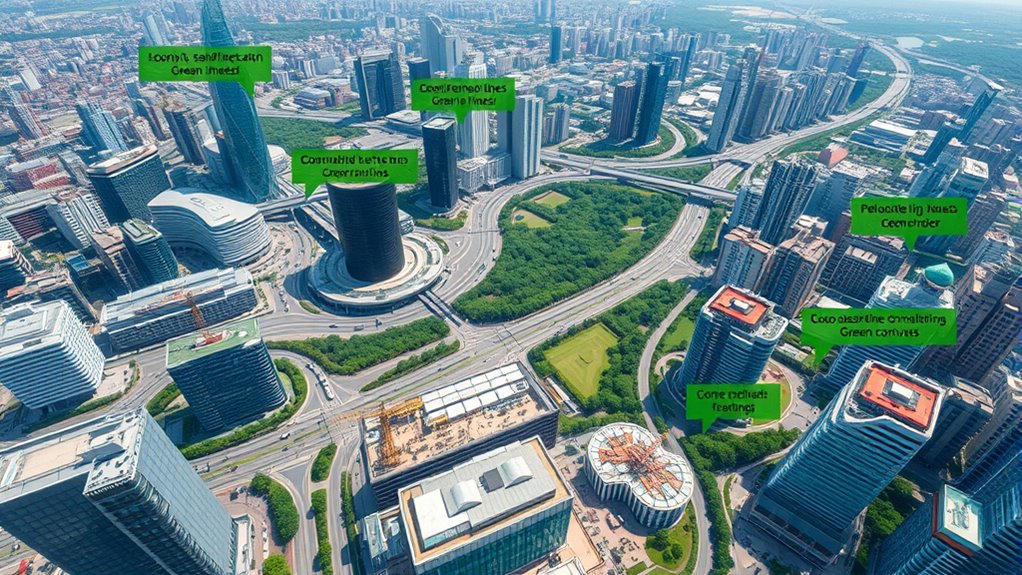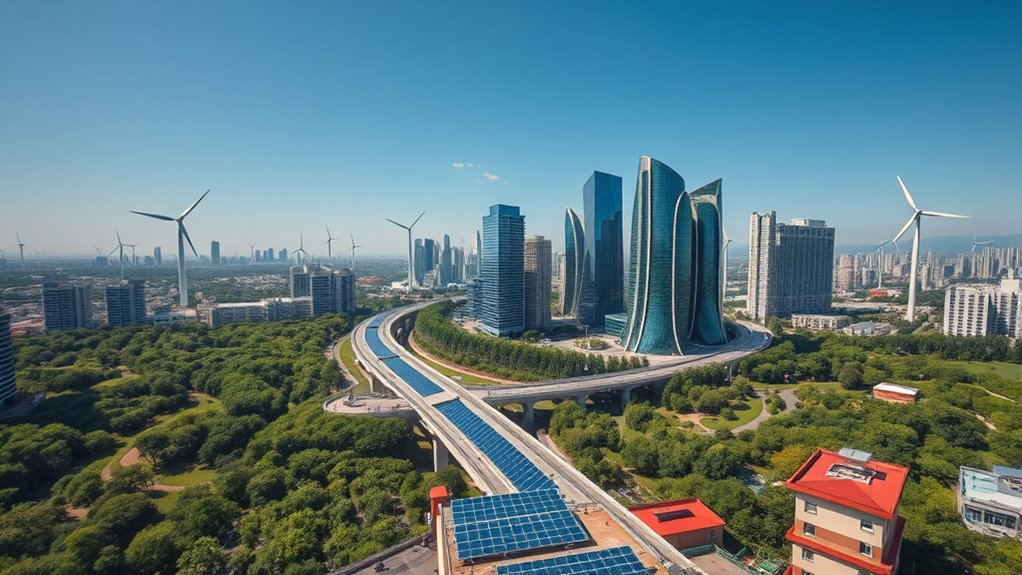Environmental regulations shape your infrastructure investments by influencing project planning, increasing compliance costs, and prompting the integration of sustainable practices. These rules, aimed at protecting the environment, often lead to higher expenses and longer timelines but can also make projects more viable through incentives like subsidies or tax breaks. Understanding the complex regulatory landscape helps you manage risks and optimize your investments. Keep exploring to uncover how to navigate these challenges effectively and capitalize on opportunities.
Key Takeaways
- Environmental regulations influence project design, costs, and timelines, impacting overall infrastructure investment feasibility.
- Incentives for renewable energy can offset compliance costs, enhancing project financial viability.
- Stricter or evolving regulations increase compliance expenses, potentially causing delays and higher total investments.
- Navigating complex regulatory landscapes requires strategic planning to mitigate risks and ensure timely project execution.
- Balancing environmental standards, incentives, and economic goals is crucial for sustainable and cost-effective infrastructure development.

Environmental regulations play an essential role in shaping infrastructure investments, often influencing how projects are planned and executed. When you’re considering building new roads, power plants, or public transit systems, you must navigate a complex landscape of rules designed to protect the environment. These regulations can considerably impact the costs, timelines, and overall feasibility of your projects. One critical area affected by these rules is renewable incentives, which are designed to encourage the adoption of clean energy sources like wind and solar. While these incentives can make renewable projects more attractive and financially viable, they also come with compliance costs that you need to account for from the outset. The availability of subsidies or tax breaks might offset some expenses, but meeting specific standards often requires additional investment in technology, monitoring, and reporting.
Compliance costs are a major consideration because they directly influence your project’s budget and logistics. These costs include expenses related to environmental impact assessments, obtaining permits, implementing pollution control measures, and ongoing monitoring to ensure adherence to regulations. When regulations are strict or continuously evolving, you might find yourself facing higher compliance costs, which can lead to delays and increased overall investment. It’s essential to understand that these costs aren’t just financial; they can also affect your project’s design and operational choices. For example, opting for greener materials or more advanced pollution control technology might raise initial expenses but could ultimately save money by avoiding penalties or future retrofits. Additionally, adopting raw food diets in project planning can promote a more sustainable approach, aligning with environmental goals and reducing resource consumption.
Moreover, environmental regulations often require you to balance multiple priorities. You need to align your project goals with environmental standards, community concerns, and economic constraints. This balancing act can add layers of complexity, especially when regulations change or become more stringent over time. As someone involved in infrastructure investments, you must stay informed about current policy trends, potential updates, and available incentives for renewable energy. Doing so allows you to proactively incorporate these factors into your planning, reducing the risk of costly adjustments later on. Ultimately, understanding the interplay between renewable incentives and compliance costs helps you make smarter decisions, ensuring your investments are both environmentally responsible and economically sustainable. Being prepared for these regulatory impacts ensures you can navigate the hurdles effectively and capitalize on opportunities to promote sustainable infrastructure development.
Frequently Asked Questions
How Do Environmental Regulations Vary Globally?
You’ll notice that environmental regulations vary globally, with some countries emphasizing strict cross-border compliance and others adopting more lenient policies. Regulatory harmonization efforts aim to create consistent standards across regions, simplifying international infrastructure investments. This variation can impact project timelines and costs, as you navigate differing legal requirements. By understanding these differences, you can better strategize your investments, ensuring compliance and optimizing your infrastructure development across diverse regulatory environments.
What Are the Long-Term Economic Benefits of Green Infrastructure?
Investing in green infrastructure offers long-term economic benefits by boosting green job creation and improving resilience. A thorough cost-benefit analysis shows these projects reduce energy costs and mitigate climate risks, leading to sustainable growth. You’ll find that over time, the initial investments pay off through lower operational expenses and enhanced community well-being, making green infrastructure a smart choice for economic stability and environmental health.
How Do Regulations Impact Innovation in Infrastructure Projects?
Regulations can both hinder and promote innovation in infrastructure projects. When you face innovation barriers, it may slow down adopting new technologies. However, regulatory incentives encourage you to develop sustainable solutions by offering benefits like grants or streamlined approval processes. By balancing these factors, you can leverage regulations to push for innovative infrastructure, ultimately leading to more resilient and eco-friendly developments that benefit communities and the environment.
What Role Do Public Stakeholders Play in Regulatory Decisions?
You play a vital role in regulatory decisions through public participation and advocating for policy transparency. Imagine a lively town hall, where your voice echoes alongside others, shaping the rules that guide infrastructure projects. Your involvement guarantees decisions reflect community needs, holding policymakers accountable. By engaging actively, you help create a transparent process, influencing regulations that balance environmental goals with infrastructure growth, ultimately shaping the future you want to see.
How Are Developing Countries Affected Differently by These Regulations?
You’ll find that developing countries face unique challenges with environmental regulations, mainly due to socioeconomic disparities and policy enforcement challenges. These nations often struggle to balance economic growth with environmental protection, leading to delays or lax enforcement. As a result, infrastructure investments may slow down or become less sustainable, impacting long-term development goals. Addressing these disparities and strengthening enforcement are vital to guarantee regulations effectively support both growth and environmental health.
Conclusion
Think of environmental regulations as the steering wheel guiding infrastructure investments through a stormy sea. While they may slow you down temporarily, they ultimately help steer your projects toward a sustainable future. Embracing these regulations isn’t about hitting brakes but about maneuvering wisely. By balancing growth with responsibility, you can chart a course that benefits both the environment and your long-term investments—your ship sailing smoothly into a greener horizon.









